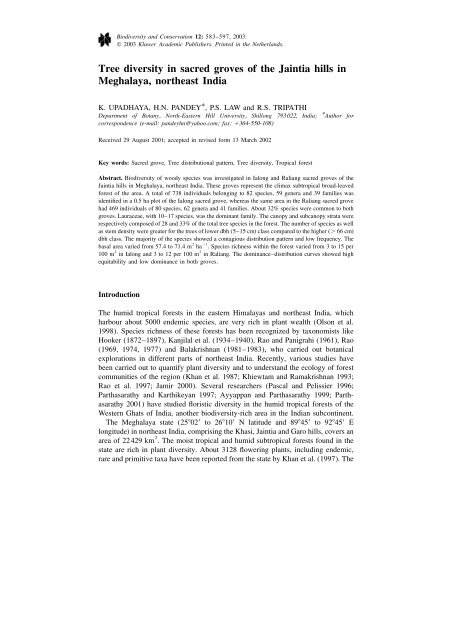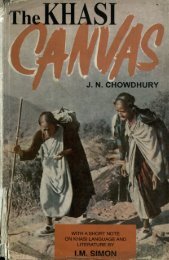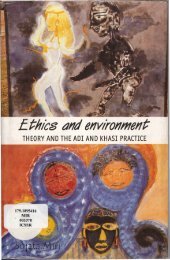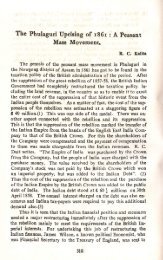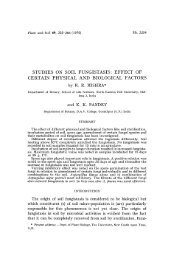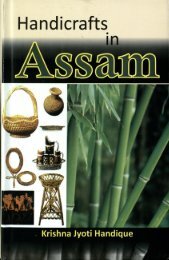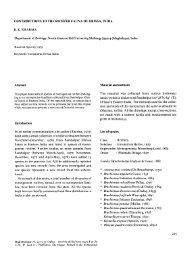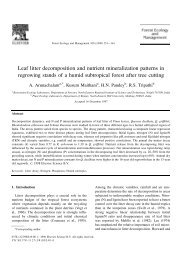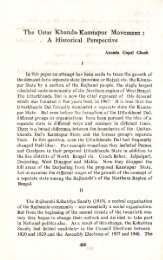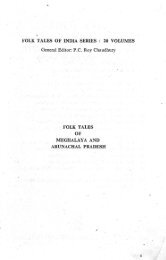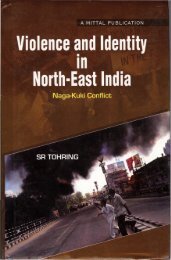Tree diversity in sacred groves of the Jaintia - DSpace@NEHU ...
Tree diversity in sacred groves of the Jaintia - DSpace@NEHU ...
Tree diversity in sacred groves of the Jaintia - DSpace@NEHU ...
Create successful ePaper yourself
Turn your PDF publications into a flip-book with our unique Google optimized e-Paper software.
Bio<strong>diversity</strong> and Conservation 12: 583–597, 2003.<br />
© 2003 Kluwer Academic Publishers. Pr<strong>in</strong>ted <strong>in</strong> <strong>the</strong> Ne<strong>the</strong>rlands.<br />
<strong>Tree</strong> <strong>diversity</strong> <strong>in</strong> <strong>sacred</strong> <strong>groves</strong> <strong>of</strong> <strong>the</strong> Ja<strong>in</strong>tia hills <strong>in</strong><br />
Meghalaya, nor<strong>the</strong>ast India<br />
K. UPADHAYA, H.N. PANDEY * , P.S. LAW and R.S. TRIPATHI<br />
Department <strong>of</strong> Botany, North-Eastern Hill University, Shillong 793 022, India; * Author for<br />
correspondence (e-mail: pandeyhn@yahoo.com; fax: 1364-550-108)<br />
Received 29 August 2001; accepted <strong>in</strong> revised form 13 March 2002<br />
Key words: Sacred grove, <strong>Tree</strong> distributional pattern, <strong>Tree</strong> <strong>diversity</strong>, Tropical forest<br />
Abstract. Bio<strong>diversity</strong> <strong>of</strong> woody species was <strong>in</strong>vestigated <strong>in</strong> Ialong and Raliang <strong>sacred</strong> <strong>groves</strong> <strong>of</strong> <strong>the</strong><br />
Ja<strong>in</strong>tia hills <strong>in</strong> Meghalaya, nor<strong>the</strong>ast India. These <strong>groves</strong> represent <strong>the</strong> climax subtropical broad-leaved<br />
forest <strong>of</strong> <strong>the</strong> area. A total <strong>of</strong> 738 <strong>in</strong>dividuals belong<strong>in</strong>g to 82 species, 59 genera and 39 families was<br />
identified <strong>in</strong> a 0.5 ha plot <strong>of</strong> <strong>the</strong> Ialong <strong>sacred</strong> grove, whereas <strong>the</strong> same area <strong>in</strong> <strong>the</strong> Raliang <strong>sacred</strong> grove<br />
had 469 <strong>in</strong>dividuals <strong>of</strong> 80 species, 62 genera and 41 families. About 32% species were common to both<br />
<strong>groves</strong>. Lauraceae, with 10–17 species, was <strong>the</strong> dom<strong>in</strong>ant family. The canopy and subcanopy strata were<br />
respectively composed <strong>of</strong> 28 and 33% <strong>of</strong> <strong>the</strong> total tree species <strong>in</strong> <strong>the</strong> forest. The number <strong>of</strong> species as well<br />
as stem density were greater for <strong>the</strong> trees <strong>of</strong> lower dbh (5–15 cm) class compared to <strong>the</strong> higher (. 66 cm)<br />
dbh class. The majority <strong>of</strong> <strong>the</strong> species showed a contagious distribution pattern and low frequency. The<br />
2 21<br />
basal area varied from 57.4 to 71.4 m ha . Species richness with<strong>in</strong> <strong>the</strong> forest varied from 3 to 15 per<br />
2 2<br />
100 m <strong>in</strong> Ialong and 3 to 12 per 100 m <strong>in</strong> Raliang. The dom<strong>in</strong>ance–distribution curves showed high<br />
equitability and low dom<strong>in</strong>ance <strong>in</strong> both <strong>groves</strong>.<br />
Introduction<br />
The humid tropical forests <strong>in</strong> <strong>the</strong> eastern Himalayas and nor<strong>the</strong>ast India, which<br />
harbour about 5000 endemic species, are very rich <strong>in</strong> plant wealth (Olson et al.<br />
1998). Species richness <strong>of</strong> <strong>the</strong>se forests has been recognized by taxonomists like<br />
Hooker (1872–1897), Kanjilal et al. (1934–1940), Rao and Panigrahi (1961), Rao<br />
(1969, 1974, 1977) and Balakrishnan (1981–1983), who carried out botanical<br />
explorations <strong>in</strong> different parts <strong>of</strong> nor<strong>the</strong>ast India. Recently, various studies have<br />
been carried out to quantify plant <strong>diversity</strong> and to understand <strong>the</strong> ecology <strong>of</strong> forest<br />
communities <strong>of</strong> <strong>the</strong> region (Khan et al. 1987; Khiewtam and Ramakrishnan 1993;<br />
Rao et al. 1997; Jamir 2000). Several researchers (Pascal and Pelissier 1996;<br />
Parthasarathy and Karthikeyan 1997; Ayyappan and Parthasarathy 1999; Parthasarathy<br />
2001) have studied floristic <strong>diversity</strong> <strong>in</strong> <strong>the</strong> humid tropical forests <strong>of</strong> <strong>the</strong><br />
Western Ghats <strong>of</strong> India, ano<strong>the</strong>r bio<strong>diversity</strong>-rich area <strong>in</strong> <strong>the</strong> Indian subcont<strong>in</strong>ent.<br />
The Meghalaya state (258029 to 268109 N latitude and 898459 to 928459 E<br />
longitude) <strong>in</strong> nor<strong>the</strong>ast India, compris<strong>in</strong>g <strong>the</strong> Khasi, Ja<strong>in</strong>tia and Garo hills, covers an<br />
2<br />
area <strong>of</strong> 22429 km . The moist tropical and humid subtropical forests found <strong>in</strong> <strong>the</strong><br />
state are rich <strong>in</strong> plant <strong>diversity</strong>. About 3128 flower<strong>in</strong>g plants, <strong>in</strong>clud<strong>in</strong>g endemic,<br />
rare and primitive taxa have been reported from <strong>the</strong> state by Khan et al. (1997). The
584<br />
<strong>in</strong>digenous tribes <strong>of</strong> <strong>the</strong> state have an age-old tradition <strong>of</strong> preserv<strong>in</strong>g small patches<br />
<strong>of</strong> old growth forests as a part <strong>of</strong> <strong>the</strong>ir culture and religious beliefs. These forests,<br />
popularly known as <strong>sacred</strong> <strong>groves</strong>, are bio<strong>diversity</strong>-rich communities, which provide<br />
refuge for a large number <strong>of</strong> endemic and rare plant taxa <strong>of</strong> <strong>the</strong> region. In India,<br />
several studies have been made on <strong>the</strong> vegetation structure, composition and<br />
ecology <strong>of</strong> <strong>the</strong> <strong>sacred</strong> <strong>groves</strong> <strong>of</strong> Meghalaya (Barik et al. 1992; Khiewtam and<br />
Ramakrishnan 1993; Rao et al. 1997; Jamir 2000) and some o<strong>the</strong>r parts <strong>of</strong> India (cf.<br />
Chandrashekara and Sankar 1998; Ramakrishnan et al. 1998). This paper deals with<br />
<strong>the</strong> <strong>diversity</strong> <strong>of</strong> woody species (trees and lianas) and <strong>the</strong> structure <strong>of</strong> <strong>the</strong> two <strong>sacred</strong><br />
<strong>groves</strong> located <strong>in</strong> <strong>the</strong> Ja<strong>in</strong>tia hills <strong>of</strong> Meghalaya.<br />
Study site<br />
The study was conducted <strong>in</strong> Ialong and Raliang <strong>sacred</strong> <strong>groves</strong> <strong>in</strong> <strong>the</strong> Ja<strong>in</strong>tia hills, <strong>the</strong><br />
eastern district <strong>of</strong> Meghalaya. These <strong>groves</strong> are remnants <strong>of</strong> subtropical broadleaved<br />
forest (Champion and Seth 1968), which presumably is <strong>the</strong> climax vegetation<br />
<strong>of</strong> <strong>the</strong> area. The important tree species that constituted <strong>the</strong> forest canopy were<br />
Engelhardtia spicata, Ficus sp., Castanopsis purpurella, Syzygium tetragonum,<br />
Sarcosperma griffithii, Prunus jenkensii and Neolitsea cassia. These <strong>groves</strong> have<br />
been protected s<strong>in</strong>ce time immemorial by <strong>the</strong> Ja<strong>in</strong>tia tribe due to <strong>the</strong>ir strong<br />
religious beliefs. The Ialong <strong>sacred</strong> grove is located about 8 km east <strong>of</strong> Jowai town<br />
at an altitude <strong>of</strong> 1350 m a.s.l. (latitude 258289 N and longitude 928259 E), while <strong>the</strong><br />
Raliang <strong>sacred</strong> grove is 28 km away from Jowai town <strong>in</strong> <strong>the</strong> nor<strong>the</strong>ast direction<br />
(altitude 1300 m a.s.l., latitude 258309 N, longitude 928189 E). The Ialong <strong>sacred</strong><br />
grove is spread over an area <strong>of</strong> about 30 ha on a steep hill slope (208 to . 608), while<br />
<strong>the</strong> Raliang <strong>sacred</strong> grove covers an area <strong>of</strong> 20 ha on a gently slop<strong>in</strong>g (10–258) hill.<br />
The climate <strong>of</strong> <strong>the</strong> area is monsoonic with dist<strong>in</strong>ct alternate wet and dry seasons.<br />
The wet season extends from April to October, followed by a dry period from<br />
November to March. Dur<strong>in</strong>g <strong>the</strong> wet season monthly ra<strong>in</strong>fall ranges from 131 to<br />
1557 mm, while <strong>in</strong> <strong>the</strong> dry period it is usually , 50 mm per month. The annual<br />
ra<strong>in</strong>fall was 6539 mm dur<strong>in</strong>g <strong>the</strong> study period (1999–2000). Relative humidity also<br />
exhibited marked seasonal variation and was closely related to precipitation. The<br />
mean monthly temperature varied from a maximum <strong>of</strong> 26 8C <strong>in</strong> <strong>the</strong> month <strong>of</strong> April<br />
to a m<strong>in</strong>imum <strong>of</strong> 5 8C <strong>in</strong> January (Figure 1).<br />
The soil <strong>of</strong> <strong>the</strong> <strong>sacred</strong> <strong>groves</strong> was loamy (Raliang) to loamy sand (Ialong) and<br />
acidic (pH 4.5–4.62).<br />
Methods<br />
Vegetation sampl<strong>in</strong>g was done dur<strong>in</strong>g 1999–2000 by randomly lay<strong>in</strong>g 50 quadrats<br />
2<br />
<strong>of</strong> 100 m <strong>in</strong> each <strong>of</strong> <strong>the</strong> two <strong>groves</strong>. All woody species ($ 5 cm dbh) <strong>in</strong> each<br />
quadrat were tagged and measured. They were identified with <strong>the</strong> help <strong>of</strong> <strong>the</strong> Flora<br />
<strong>of</strong> Jowai (Balakrishnan 1981–1983), <strong>the</strong> Forest Flora <strong>of</strong> Meghalaya (Haridasan and
585<br />
Figure 1. Monthly mean temperature (max and m<strong>in</strong>), relative humidity and ra<strong>in</strong>fall at Jowai dur<strong>in</strong>g<br />
January 1999 and 2000.<br />
Rao 1985–1987) and <strong>the</strong> Flora <strong>of</strong> Assam (Kanjilal et al. 1934–1940). The Herbaria<br />
<strong>of</strong> Botanical Survey <strong>of</strong> India, Eastern Circle, Shillong and Botany Department,<br />
NEHU, Shillong, were consulted for correct identification <strong>of</strong> plant specimens. The<br />
nomenclature <strong>of</strong> species follows <strong>the</strong> regional flora.<br />
Frequency, density, dom<strong>in</strong>ance and importance value <strong>in</strong>dex (IVI) <strong>of</strong> all woody<br />
species were determ<strong>in</strong>ed accord<strong>in</strong>g to Misra (1968) and Muller-Dombois and<br />
Ellenberg (1974). The Whitford <strong>in</strong>dex was used to study dispersion patterns<br />
2<br />
(Whitford 1948). Shannon’s <strong>diversity</strong> <strong>in</strong>dex (H ) and Simpson’s dom<strong>in</strong>ance <strong>in</strong>dex<br />
(l) were calculated accord<strong>in</strong>g to Magurran (1988). Species richness was studied on<br />
2<br />
<strong>the</strong> basis <strong>of</strong> number <strong>of</strong> species per 100 m area.<br />
Results<br />
Species–area curve<br />
The species–area curves for <strong>the</strong> two <strong>sacred</strong> <strong>groves</strong> were very similar. After a gradual<br />
<strong>in</strong>crease <strong>in</strong> <strong>the</strong> species number with <strong>in</strong>crease <strong>in</strong> area, <strong>the</strong>y reached an asymptote at
586<br />
Figure 2. Species–area curves <strong>of</strong> <strong>the</strong> two <strong>sacred</strong> <strong>groves</strong> <strong>in</strong> <strong>the</strong> Ja<strong>in</strong>tia hills.<br />
0.35–0.4 ha. About 80% <strong>of</strong> <strong>the</strong> species were found <strong>in</strong> a 0.35 ha area, while 88–99%<br />
<strong>of</strong> <strong>the</strong> species were encountered <strong>in</strong> 0.4 ha (Figure 2).<br />
Species composition and <strong>the</strong>ir distribution pattern<br />
A total <strong>of</strong> 123 woody species was identified <strong>in</strong> a 1 ha area <strong>of</strong> <strong>the</strong> two <strong>sacred</strong> <strong>groves</strong><br />
(Table 1). This <strong>in</strong>cluded two gymnosperms, viz. P<strong>in</strong>us kesiya <strong>in</strong> Ialong and<br />
Podocarpus neriifolia <strong>in</strong> Raliang <strong>sacred</strong> grove. In both <strong>groves</strong>, trees were distributed<br />
<strong>in</strong> three dist<strong>in</strong>ct strata, namely canopy (. 15 m height), subcanopy (8–15 m<br />
height) and under canopy (, 8 m height). The canopy layer was composed <strong>of</strong> Acer<br />
laevigatum, Betula alnoides, Castanopsis sp., C<strong>in</strong>namomum sp., Ficus altissima<br />
and F. virens, while Antidesma bunius, Diospyros kaki, Pi<strong>the</strong>cellobium monodelphum,<br />
Helicia nilagirica, and Schefflera hypoleuca constituted subcanopy stratum.<br />
C<strong>of</strong>fea khasiana, Erythroxylon kunthianum, F. hirta, Microtropis discolor, Sarcococca<br />
pruniformis and Wendlandia wallichii formed <strong>the</strong> under canopy layer. The<br />
subcanopy, with 40 species, was <strong>the</strong> most species-rich layer <strong>in</strong> both <strong>sacred</strong> <strong>groves</strong>.<br />
2<br />
Species richness (number <strong>of</strong> species per 100 m area) clearly <strong>in</strong>dicated that both <strong>the</strong><br />
communities were a mosaic <strong>of</strong> high- and low-<strong>diversity</strong> patches (Figure 3A).<br />
A total <strong>of</strong> 82 species belong<strong>in</strong>g to 59 genera and 39 families and 80 species<br />
belong<strong>in</strong>g to 62 genera <strong>of</strong> 41 families were identified <strong>in</strong> 0.5 ha plots <strong>in</strong> <strong>the</strong> Ialong<br />
and Raliang <strong>sacred</strong> <strong>groves</strong>, respectively. About 32% <strong>of</strong> <strong>the</strong> species were common to<br />
both <strong>groves</strong>. Lauraceae with 10 species, Fagaceae and Moraceae (eight species<br />
each), Araliaceae, Rubiaceae and Theaceae (five species each), Euphorbiaceae (four
587<br />
Figure 3. (A) Spatial distribution <strong>of</strong> species richness <strong>in</strong> <strong>the</strong> two <strong>sacred</strong> <strong>groves</strong>. (B) Distribution <strong>of</strong> species<br />
<strong>in</strong> different diameter classes <strong>in</strong> <strong>the</strong> two <strong>sacred</strong> <strong>groves</strong>.
588<br />
Table 1. Frequency (%), density (number <strong>of</strong> plants per ha) and IVI <strong>of</strong> woody species ($ 5 cm dbh) <strong>in</strong><br />
Ialong and Raliang <strong>sacred</strong> <strong>groves</strong>.<br />
Plant species Family Ialong Raliang<br />
Frequency Density IVI Frequency Density IVI<br />
Canopy layer (15 m height)<br />
Acer laevigatum Wall. Aceraceae 4 6 1.48 16 26 11.41<br />
A. oblongum Wall. Aceraceae – – – 2 2 0.68<br />
Act<strong>in</strong>odaphne obovata (Nees) Kosterm Lauraceae – – – 50 108 25.59<br />
Alseodaphne petiolaris Hk.f. Lauraceae 2 6 1.85 6 6 1.79<br />
Betula alnoides Buch-Ham Betulaceae 12 12 16.13 2 4 2.39<br />
Castanopsis <strong>in</strong>dica (Roxb) DC Fagaceae 10 10 2.44 – – –<br />
C. purpurella (Miq.) Balakr. Fagaceae 36 62 14.56 8 14 6.58<br />
C. tribuloides (Sm.) DC Fagaceae 20 30 12.9 – – –<br />
C<strong>in</strong>namomum bejolghota (Buch.-Ham.) Sweet. Lauraceae 2 2 0.58 2 2 2.02<br />
Ci. glanduliferum (Wall.) Meissn. Lauraceae 16 16 5.79 – – –<br />
Ci. glaucescens (Nees) Meissn. Lauraceae – – – 2 2 3.40<br />
Cryptocarya floribunda Nees Lauraceae – – – 6 6 2.05<br />
Drymicarpus racemosus (Roxb) Hk.f. Anacardiaceae – – – 18 20 5.38<br />
Elaeocarpus sikkimensis Mast. Elaeocarpaceae – – – 2 2 0.59<br />
Engelhardtia spicata Bl. Juglandaceae 28 40 18.34 6 8 4.81<br />
Ficus altissima Bl. Moraceae 6 8 7.40 4 4 12.92<br />
F. virens Ait. Moraceae 4 4 6.58 8 10 16.08<br />
Garc<strong>in</strong>ia t<strong>in</strong>ctoria (DC.) W.F. Wight Clusiaceae 2 2 0.53 4 4 1.27<br />
Knema angustifolia (Roxb.) Warb. Myristicaceae – – – 22 28 7.72<br />
Lithocarpus elagans Soepadmo Fagaceae 20 28 3.46 14 14 7.89<br />
L. fenestrata (Roxb) Rehder Fagaceae 10 12 2.45 2 2 0.53<br />
Lithocarpus sp. Fagaceae 6 8 5.55 2 2 0.52<br />
Michelia doltsopa DC. Magnoliaceae – – – 2 2 3.90<br />
Neolitsea cassia (L.) Kosterm. Lauraceae – – – 32 64 16.47<br />
Persea gamblei (K<strong>in</strong>g ex Hk.f.) Kosterm. Lauraceae – – – 4 4 1.82<br />
Pe. odoratissima (Nees) Kosterm. Lauraceae 14 18 6.06 6 10 3.76<br />
P<strong>in</strong>us kesiya Royle ex. G. Don P<strong>in</strong>aceae 2 2 1.19 – – –<br />
Podocarpus neriifolia D. Don Podocarpaceae – – – 2 2 1.01<br />
Prunus jenk<strong>in</strong>sii Hook. f. Rosaceae 14 20 4.06 48 78 19.97<br />
Pseudostreblus <strong>in</strong>dica Bureau Moraceae 16 48 14.2 – – –<br />
Quercus serrata Thunb. Fagaceae 2 2 0.65 – – –<br />
Sarcosperma griffithii Clarke Sapotaceae – – – 72 116 36.88<br />
Schima wallichii Dyer Theaceae 14 20 3.84 4 4 1.50<br />
Spondias axillaris Roxb. Anacardiaceae – – – 2 2 2.26<br />
Syzygium tetragonum (Wt.) Kurz Myrtaceae 38 60 12.55 12 14 3.74<br />
Subcanopy layer (8–15 m height)<br />
Alangium ch<strong>in</strong>ensis (Lour) Harms Cornaceae 14 16 4.08 – – –<br />
Antidesma bunius (L.) Spreng. Euphorbiaceae 2 2 0.4 2 2 0.52<br />
Beilschmiedia assamica Meissn Lauraceae – – – 8 8 2.23<br />
B. roxburghiana Nees Lauraceae 2 2 0.47 – – –<br />
Caryota urens L<strong>in</strong>n. Arecaceae – – – 8 8 2.23<br />
Ci. tamala (Spreng.) Nees & Eberm Lauraceae – – – 4 4 1.05<br />
Citrus latipes (Sw<strong>in</strong>gle) Tanaka Rutaceae 8 8 1.78 6 6 1.56<br />
Diospyros kaki L.f. Ebenaceae 6 8 1.40 2 2 0.62<br />
Dysoxylon gobara (Buch.-Ham.) Merr. Meliaceae – – – 42 62 14.07<br />
El. Lancifolius Roxb. Elaeocarpaceae – – – 2 2 0.55
Table 1. (cont<strong>in</strong>ued)<br />
Plant species Family Ialong Raliang<br />
589<br />
Frequency Density IVI Frequency Density IVI<br />
Erythr<strong>in</strong>a arborescens Roxb. Fabaceae 2 2 0.40 – – –<br />
Eurya acum<strong>in</strong>ata DC. Theaceae 2 4 0.56 – – –<br />
F. conc<strong>in</strong>na Meq. Moraceae 2 2 0.55 – – –<br />
F. mclelandi var. rhododendrifolia Corn. Moraceae 2 2 0.68 – – –<br />
F. nerifolia J. E. Sm. Moraceae 2 2 0.43 2 2 0.52<br />
G. morella Desr. Clusiaceae 2 6 1.22 – – –<br />
Helecia nilagirica Bedd. Proteaceae 38 62 9.76 10 28 5.23<br />
Ilex embeloides Hook. f. Aqualifoliaceae – – – 2 4 0.75<br />
L<strong>in</strong>dera latifolia Hook. f. Lauraceae 16 28 4.5 8 10 2.45<br />
Li. nagusa (D. Don) Merr. Lauraceae 2 2 0.40 – – –<br />
Li. reticulata Benth. Lauraceae – – – 8 8 3.16<br />
Litsea semicarpifolia (Nees) Hook. f. Lauraceae – – – 8 10 2.47<br />
Macaranga denticulata (Bl.) Muell-Arg. Euphorbiaceae – – – 4 4 1.47<br />
Macropanax dispermus (Bl.) O. Ktze Araliaceae 2 2 0.40 20 24 6.05<br />
Manglietia <strong>in</strong>signis (Wall) Bl. Magnoliaceae 2 2 0.40 6 8 2.87<br />
Melia azedarach L<strong>in</strong>n. Meliaceae – – – 2 2 0.52<br />
Myrica esculanta Buch.-Ham. ex D. Don Myricaceae 6 6 2.85 2 2 0.55<br />
Myrs<strong>in</strong>e semiserrata Wall. Myrs<strong>in</strong>aceae 10 14 2.37 2 2 0.52<br />
Pe. bombocyania (K<strong>in</strong>g ex Hk. f.) Kosterm. Lauraceae 2 4 0.73 2 2 0.52<br />
Pe. duthiei (Hook. f.) Kosterm. Lauraceae 2 4 1.03 – – –<br />
Pe. parviflora Meissn. Lauraceae – – – 4 4 1.27<br />
Pi<strong>the</strong>cellobium monadelphum (Roxb.) Kosterm. Mimosaceae 34 50 9.18 16 18 4.44<br />
P. acum<strong>in</strong>ata (Wall) Dietr. Rosaceae – – – 4 6 1.26<br />
Q. griffithii Hk. f. & Th ex DC. Fagaceae 2 2 0.73 – – –<br />
Rhododendron arboreaum Sm. Ericaceae 2 2 0.55 – – –<br />
Rhus acum<strong>in</strong>ata DC. Anacardiaceae 28 36 8.73 – – –<br />
Sap<strong>in</strong>dus rarak DC. Sap<strong>in</strong>daceae – – – 2 2 0.52<br />
Schefflera elata (Buch.-Ham.) Harms Araliaceae 4 4 0.89 – – –<br />
Sc. Hypoleuca (Kurz) Harms Araliaceae 22 22 4.63 4 4 1.05<br />
Vacc<strong>in</strong>ium sprengelii (G. Don) Rehd. Vacc<strong>in</strong>iaceae 2 4 0.66 – – –<br />
Under canopy (, 8 m height)<br />
Ant. khasiana Hk. f. Euphorbiaceae 2 2 0.40 – – –<br />
Calophyllum polyanthium Choisy Clusiaceae – – – 2 2 0.52<br />
Camellia caudata Wall. Theaceae 30 136 13.86 – – –<br />
Capparis acutifolia Sweet Capparaceae – – – 24 28 6.92<br />
Clerodendron bracteatum Walp. Verbenaceae 2 2 0.40 – – –<br />
C<strong>of</strong>fea khasiana Hook. f. Rubiaceae 54 100 13.96 4 4 1.04<br />
Croton oblongus Burm. f Euphorbiaceae 4 4 0.85 – – –<br />
Desmos longiflorus (Roxb.) Safford Annonaceae – – – 6 6 1.60<br />
Erythroxylon kunthianum Kurz. Erythroxylaceae 2 2 0.40 2 2 0.52<br />
Eu. cerasifolia (D. Don) Kobuski Theaceae 10 14 2.11 – – –<br />
Eu. japonica Thunb Theaceae 2 2 0.40 – – –<br />
F. elmerii Merr. Moraceae 2 2 0.40 – – –<br />
F. hirta var. roxburghii (Mig) K<strong>in</strong>g Moraceae 8 8 1.56 4 4 1.05<br />
Itea ch<strong>in</strong>ensis Hook. & Arn. Iteaceae – – – 2 2 0.52<br />
I. macrophylla Wall. Iteaceace 2 2 0.47 – – –<br />
Ixora subsessilis G. Don. Rubiaceae 2 2 0.70 10 10 3.23<br />
Li. salicifolia (Nees) Hook. f. Lauraceae – – – 2 2 0.52<br />
Maesa <strong>in</strong>dica (Roxb.) Wall. Myrs<strong>in</strong>aceae 2 2 0.40 – – –
590<br />
Table 1. (cont<strong>in</strong>ued)<br />
Plant species Family Ialong Raliang<br />
Frequency Density IVI Frequency Density IVI<br />
Mynea sp<strong>in</strong>osa L<strong>in</strong>k. Rubiaceae 4 4 0.79 – – –<br />
Microtropis discolor (Wall.) Arn. Celastraceae 58 298 29.49 – – –<br />
Ant. diandrum (Roxb.) Roth Euphorbiaceae 2 2 0.40 – – –<br />
Paramignya micrantha Kurz Rutaceae – – – 6 6 1.56<br />
Phoebe lanceolata (Nees) Nees Lauraceae 16 20 3.79 2 2 0.52<br />
Picresema sp. Simaroubaceae 6 8 1.31 – – –<br />
Pittosporum podocarpum Gagnep. Pittosporaceae – – – 6 6 1.65<br />
Pouzolzia frondosa var. fulgens (Wedd.) Balakr. Urticaceae 2 2 0.42 – – –<br />
Pseudobrassiopsis hispida (Seem.) R. N. Ban. Araliaceae 4 4 0.78 – – –<br />
Pyrularia edulis (Wall.) DC. Santalaceae 14 20 3.62 – – –<br />
Randia griffithii Hook. f. Rubiaceae 2 2 0.40 – – –<br />
Sarcococca pruniformis L<strong>in</strong>dl. Buxaceae 10 10 2.22 2 8 1.47<br />
Stercularia hamiltonii (O. Ktze.) Adelb. Sterculiaceae – – – 4 6 1.38<br />
Styrax serrulatum Roxb. Styracaceae 8 10 1.71 6 6 1.62<br />
St. hookerii Cl. Styracaceae 2 2 0.40 – – –<br />
Symplocos pyrifolia G. Don. Symplocaceae – – – 6 6 1.66<br />
Sy. spicata Roxb Symplocaceae 8 10 1.96 2 2 0.52<br />
Viburnum foetidum Wall. Caprifoliaceae 2 2 0.40 – – –<br />
Wendlandia wallichii W. & A. Prodr. Rubiaceae 10 20 3.22 4 4 1.05<br />
Lianas<br />
Embelia subcoriaceous (Clarke). Mez. Myrs<strong>in</strong>aceae 4 4 0.77 – – –<br />
Fissistigma verrucosum (Hook. f. & Th.) Merr Annonaceae – – – 10 14 3.09<br />
Melod<strong>in</strong>us monogynous Roxb. Apocynaceae – – – 2 2 0.52<br />
Rourea m<strong>in</strong>or (Gaertn.) Leenh. Connanaceae 24 44 6.22 10 12 2.92<br />
Sc. venulosa (W. & A.) Harms Araliaceae – – – 2 2 0.52<br />
Sc. wallichiana (W. & A.) Harms Araliaceae 2 2 0.40 – – –<br />
Tetrastigma leucostaphylum (Dennest.) Balakr. Vitaceae – – – 2 2 0.53<br />
T. serullatum (Roxb.) Planch. Vitaceae 12 14 2.49 – – –<br />
Todallia asiatica (L.) Lamk. Rutaceae 4 6 0.93 – – –<br />
Tupidanthus calyptratus Hook. f. & Thoms. Araliaceae – – – 4 4 1.17<br />
Unidentified sp. – – – – 2 2 0.52<br />
Total 1476 300 938 300<br />
species) and Myrs<strong>in</strong>aceae (three species) were well represented <strong>in</strong> <strong>the</strong> Ialong <strong>sacred</strong><br />
grove. Three families, Clusiaceae, Rutaceae and Styracaceae, were represented by<br />
two species each, whereas 28 families were monospecific. Similarly, <strong>in</strong> <strong>the</strong> Raliang<br />
<strong>sacred</strong> grove, Lauraceae with 17 species was <strong>the</strong> dom<strong>in</strong>ant family followed by<br />
Araliaceae, Fagaceae and Moraceae (four species each) and Rubiaceae (three<br />
species). Eleven families had two species each and 25 families were represented by<br />
only one species.<br />
In both <strong>groves</strong>, <strong>the</strong> majority <strong>of</strong> species (65) were represented by young <strong>in</strong>dividuals<br />
(5–15 cm dbh) and species richness decreased with <strong>in</strong>crease <strong>in</strong> dbh class,<br />
except <strong>in</strong> <strong>the</strong> case <strong>of</strong> mature trees beyond 66 cm dbh (Figure 3B). In both <strong>groves</strong><br />
87–91% <strong>of</strong> <strong>the</strong> species belonged to Raunkiaer’s frequency class A and <strong>the</strong> rest were<br />
distributed <strong>in</strong> <strong>the</strong> B, C and D classes; class E was completely absent (Table 2).<br />
Similarly, <strong>the</strong> majority <strong>of</strong> species (90–92%) showed a contagious distribution
591<br />
Table 2. Percentage distribution <strong>of</strong> species <strong>in</strong> Raunkiaer’s frequency classes <strong>in</strong> <strong>the</strong> two <strong>sacred</strong> <strong>groves</strong>.<br />
Sacred grove Raunkiaer’s frequency class<br />
A B C D E<br />
Ialong 86.6 11.0 2.4 – –<br />
Raliang 91.2 3.8 3.8 1.2 –<br />
Table 3. Percentage <strong>of</strong> species show<strong>in</strong>g different dispersion patterns (based on Whitford’s <strong>in</strong>dex) <strong>in</strong> <strong>the</strong><br />
two <strong>sacred</strong> <strong>groves</strong>.<br />
Sacred grove Whitford’s <strong>in</strong>dex<br />
Regular Random Contagious<br />
Ialong – 9.8 90.2<br />
Raliang 1.2 6.3 92.5<br />
pattern and only 6–10% <strong>of</strong> <strong>the</strong> species were randomly distributed <strong>in</strong> <strong>the</strong> forest<br />
(Table 3). Regular dispersion was seen only <strong>in</strong> case <strong>of</strong> S. griffithii.<br />
Density and basal cover<br />
Distribution <strong>of</strong> density <strong>in</strong> different dbh classes is shown <strong>in</strong> Figure 4. In Ialong and<br />
Raliang, 74% and 54%, respectively <strong>of</strong> <strong>the</strong> stems were <strong>in</strong> <strong>the</strong> 5–15 cm dbh class and<br />
only 2–5% <strong>of</strong> <strong>the</strong> <strong>in</strong>dividuals were present <strong>in</strong> <strong>the</strong> . 66 cm dbh class. The tree<br />
21<br />
density varied from 938 to 1476 ha <strong>in</strong> <strong>the</strong> two <strong>groves</strong> (Table 4). In Ialong, 738<br />
<strong>in</strong>dividuals encountered <strong>in</strong> a 0.5 ha area belonged to as many as 82 species. Most <strong>of</strong><br />
<strong>the</strong>se species (48%) were represented by one or two stems. Microtropis discolor had<br />
<strong>the</strong> maximum number <strong>of</strong> <strong>in</strong>dividuals (149 stems), followed by Camellia caudata<br />
with 68 stems (Figure 5). These species toge<strong>the</strong>r constituted 29% <strong>of</strong> <strong>the</strong> tree density<br />
<strong>in</strong> <strong>the</strong> forest. In Raliang 469 <strong>in</strong>dividuals belong<strong>in</strong>g to 80 species were present <strong>in</strong> a<br />
0.5 ha area. One or two stems represented 53% <strong>of</strong> <strong>the</strong> species. S. griffithii had <strong>the</strong><br />
highest number (58 stems), followed by Act<strong>in</strong>odaphne obovata, which had 54<br />
stems. Toge<strong>the</strong>r <strong>the</strong>y constituted about 23% <strong>of</strong> <strong>the</strong> stand density. In both <strong>sacred</strong><br />
<strong>groves</strong>, <strong>the</strong> density <strong>of</strong> young trees (5–15 cm dbh) was much greater compared to <strong>the</strong><br />
mature trees (. 66 cm dbh). However, despite this, <strong>the</strong> basal cover <strong>of</strong> young trees<br />
2 21<br />
was much lower than that <strong>of</strong> mature trees (2.72 versus 37.78 m ha ; Figure 6).<br />
Dom<strong>in</strong>ance distribution pattern<br />
The dom<strong>in</strong>ance distribution yielded log-normal curves show<strong>in</strong>g a high equitability<br />
and low dom<strong>in</strong>ance <strong>in</strong> both <strong>groves</strong> (Figure 7). Microtropis discolor (IVI 5 29.49)<br />
and E. spicata (IVI 5 18.34) <strong>in</strong> Ialong and S. griffithii (IVI 5 36.88) and Ac.<br />
obovata (IVI 5 25.59) <strong>in</strong> Raliang were dom<strong>in</strong>ant and co-dom<strong>in</strong>ant species,<br />
respectively (Table 1).
592<br />
Figure 4. Distribution <strong>of</strong> density <strong>in</strong> different diameter classes <strong>in</strong> <strong>the</strong> two <strong>sacred</strong> <strong>groves</strong>.<br />
Discussion<br />
It has been argued by several workers (cf. Brown 1981) that <strong>the</strong> productivity <strong>of</strong> <strong>the</strong><br />
system and structural complexity or heterogeneity determ<strong>in</strong>e species richness <strong>in</strong> <strong>the</strong><br />
community. O<strong>the</strong>rs have argued that nei<strong>the</strong>r ecosystem productivity nor structural<br />
complexities seem sufficient on <strong>the</strong>ir own to expla<strong>in</strong> <strong>the</strong> observed pattern <strong>of</strong> species<br />
richness (Putman 1994). Slobodk<strong>in</strong> and Sanders (1969) op<strong>in</strong>ed that species richness<br />
<strong>of</strong> any community is a function <strong>of</strong> severity, variability and predictability <strong>of</strong> <strong>the</strong><br />
environment <strong>in</strong> which it develops. Therefore, <strong>diversity</strong> tends to <strong>in</strong>crease as <strong>the</strong><br />
environment becomes more favourable and more predictable (Putman 1994). In <strong>the</strong><br />
present case it is difficult to p<strong>in</strong>po<strong>in</strong>t <strong>the</strong> exact causes <strong>of</strong> high species richness <strong>in</strong> <strong>the</strong><br />
<strong>sacred</strong> <strong>groves</strong> with <strong>the</strong> available data, but it seems that <strong>the</strong> favourable climatic<br />
conditions <strong>of</strong> <strong>the</strong> area and protection over a long period <strong>of</strong> time have played a major<br />
role <strong>in</strong> mak<strong>in</strong>g <strong>the</strong>se forest patches highly complex and species-rich. In this respect<br />
<strong>the</strong>y are similar to tropical forests at Luquillo Mounta<strong>in</strong>s <strong>in</strong> Puerto Rico (Weaver<br />
and Murphy 1990), Papua, New Gu<strong>in</strong>ea (Edwards 1977; Edwards and Grubb 1977),<br />
and Yanamono, Peru (Gentry 1988). Forests <strong>in</strong> which only one tree species<br />
constitutes 50–80% <strong>of</strong> <strong>the</strong> canopy have been considered as low-<strong>diversity</strong> forests<br />
(Connell and Lowman 1989). On <strong>the</strong> basis <strong>of</strong> this criterion, <strong>the</strong> <strong>sacred</strong> <strong>groves</strong> may<br />
be regarded as high-<strong>diversity</strong> forest s<strong>in</strong>ce ca. 28% <strong>of</strong> <strong>the</strong> tree species were present <strong>in</strong><br />
<strong>the</strong> canopy layer.<br />
Spatial distribution <strong>of</strong> species richness was not uniform <strong>in</strong> <strong>the</strong> forest; ra<strong>the</strong>r, both<br />
<strong>groves</strong> were a mosaic <strong>of</strong> low- and high-<strong>diversity</strong> patches. This seems to be <strong>the</strong> result
Figure 5. Species–stem relationship <strong>in</strong> a 0.5 ha area <strong>of</strong> <strong>the</strong> two <strong>sacred</strong> <strong>groves</strong>.<br />
593<br />
<strong>of</strong> <strong>the</strong> comb<strong>in</strong>ed effect <strong>of</strong> non-extreme stable environmental conditions and gapphase<br />
dynamics with<strong>in</strong> <strong>the</strong> forest (Whittaker 1972).<br />
S<strong>in</strong>ce <strong>the</strong> majority <strong>of</strong> <strong>the</strong> species was contagiously distributed and frequency class<br />
A was dom<strong>in</strong>ant, both <strong>groves</strong> were highly heterogeneous and patchy <strong>in</strong> terms <strong>of</strong><br />
species distribution. Poore (1968), Ashton (1969) and Herwitz (1981) have described<br />
tropical ra<strong>in</strong> forests as highly patchy communities, primarily due to gapphase<br />
dynamics. Clump<strong>in</strong>g <strong>of</strong> <strong>in</strong>dividuals <strong>of</strong> <strong>the</strong> same species is <strong>of</strong>ten clearly related<br />
to gap formation and dispersal mechanism <strong>of</strong> <strong>the</strong> species. Armesto et al. (1986)<br />
compared <strong>the</strong> dispersion pattern <strong>of</strong> trees <strong>in</strong> tropical and temperate climates <strong>in</strong><br />
different parts <strong>of</strong> <strong>the</strong> world and concluded that clump<strong>in</strong>g was characteristic <strong>of</strong> forest<br />
<strong>in</strong> which formation <strong>of</strong> canopy gaps was <strong>the</strong> chief source <strong>of</strong> disturbance. Hubbell<br />
(1979), <strong>in</strong> dry tropical forest, observed that all species were ei<strong>the</strong>r clumped or<br />
randomly dispersed, with rare species more clumped than common species.<br />
The species represented by one or two <strong>in</strong>dividuals <strong>in</strong> <strong>the</strong> study plot have been<br />
considered as rare species. The number <strong>of</strong> <strong>in</strong>dividuals <strong>of</strong> such species is probably<br />
kept low by a comb<strong>in</strong>ation <strong>of</strong> unfavourable regeneration conditions, lack <strong>of</strong><br />
appropriate habitat, or both (Hubbell 1979). Based on this criterion, 48–53% <strong>of</strong>
594<br />
Figure 6. Distribution <strong>of</strong> basal area <strong>in</strong> different diameter classes <strong>in</strong> <strong>the</strong> two <strong>sacred</strong> <strong>groves</strong>.<br />
Table 4. Density, basal area, dom<strong>in</strong>ance, <strong>diversity</strong> and evenness <strong>in</strong>dices <strong>of</strong> woody species <strong>in</strong> two <strong>sacred</strong><br />
<strong>groves</strong> <strong>in</strong> <strong>the</strong> Ja<strong>in</strong>tia hills, Meghalaya.<br />
Variable Ialong Raliang<br />
21<br />
Density (ha ) 1476 938<br />
2 21<br />
Basal area (m ha ) 57.46 71.44<br />
Shannon’s <strong>diversity</strong> <strong>in</strong>dex 3.42 3.55<br />
Pielou’s evenness <strong>in</strong>dex 0.53 0.56<br />
Simpson’s dom<strong>in</strong>ance <strong>in</strong>dex 0.067 0.052<br />
species may be termed as rare <strong>in</strong> <strong>the</strong> two <strong>groves</strong>. In this respect too, <strong>the</strong> two <strong>sacred</strong><br />
<strong>groves</strong> are similar to tropical forests, which are known to possess large numbers <strong>of</strong><br />
rare tree species. For example, Paijmans (1970), Thor<strong>in</strong>gton et al. (1982) and<br />
Parthasarathy and Karthikeyan (1997) reported that 50% <strong>of</strong> species <strong>in</strong> New Gu<strong>in</strong>ea,<br />
40% on Barro Colorado Island, Panama, and 47% <strong>in</strong> <strong>the</strong> Western Ghats forests were<br />
rare.<br />
Abundance <strong>of</strong> young <strong>in</strong>dividuals <strong>in</strong> both <strong>groves</strong>, a characteristic feature <strong>of</strong><br />
vegetation on moist and <strong>in</strong>fertile soil (Coomes and Grubb 2000), <strong>in</strong>dicates a slow<br />
rate <strong>of</strong> seedl<strong>in</strong>g and sapl<strong>in</strong>g growth <strong>in</strong> <strong>the</strong> understorey and a relatively low rate <strong>of</strong><br />
seedl<strong>in</strong>g mortality. This may also be due to tree-fall gaps hav<strong>in</strong>g a varied microenvironmental<br />
variability (Rao et al. 1997), which might have favoured <strong>the</strong> tree<br />
species hav<strong>in</strong>g different regeneration requirements (Phillips et al. 1994). The<br />
preponderance <strong>of</strong> young <strong>in</strong>dividuals <strong>in</strong> <strong>the</strong> mature forest has also been reported from
Figure 7. Dom<strong>in</strong>ance–<strong>diversity</strong> curves <strong>of</strong> woody species <strong>in</strong> <strong>the</strong> two <strong>sacred</strong> <strong>groves</strong>.<br />
595<br />
<strong>the</strong> Brazilian Amazon (Campbell et al. 1992), Costa Rica (Nadkarni et al. 1995) and<br />
<strong>the</strong> Western Ghats (Parthasarathy 2001).<br />
2 21<br />
The basal cover (57.46 and 77.44 m ha ) <strong>in</strong> both <strong>the</strong> <strong>sacred</strong> <strong>groves</strong> is close to<br />
2 21<br />
that <strong>of</strong> o<strong>the</strong>r tropical forests, such as equatorial forest (10–45 m ha ) <strong>in</strong> Kongo<br />
2 21<br />
Island, Zaire (Mosango 1991), tropical ra<strong>in</strong> forest (78 m ha ) <strong>in</strong> Amazonia<br />
2 21<br />
(Campbell et al. 1992), lower montane forest (62 m ha ) <strong>in</strong> Costa Rica (Nadkarni<br />
2 21<br />
et al. 1995), evergreen forest (55.3–78.3 m ha ) around Sengat<strong>the</strong>ri <strong>in</strong> <strong>the</strong><br />
2 21<br />
Western Ghats (Parthasarathy 2001), and <strong>in</strong> <strong>the</strong> dry evergreen forest (32.8 m ha )<br />
<strong>of</strong> Puthupet, South India (Parthasarathy and Sethi 1997).<br />
The dom<strong>in</strong>ance–distribution curve showed a log-normal distribution. A logarithmic<br />
or broken-stick distribution reflects that <strong>the</strong> community is primarily ordered<br />
with respect to one dom<strong>in</strong>at<strong>in</strong>g factor, while a log-normal distribution represents a<br />
more complex community, ordered by a multiplicity <strong>of</strong> <strong>in</strong>teractions (May 1975).<br />
The latter appears to be <strong>the</strong> case for <strong>the</strong> <strong>sacred</strong> <strong>groves</strong> under study.
596<br />
Acknowledgements<br />
The authors are thankful to <strong>the</strong> M<strong>in</strong>istry <strong>of</strong> Environment and Forests, Government<br />
<strong>of</strong> India, New Delhi for f<strong>in</strong>ancial assistance <strong>in</strong> <strong>the</strong> form <strong>of</strong> a research project<br />
(Sanction no. 14/28/95-RE, dated 30-12-1997).<br />
References<br />
Armesto J.J., Mitchell J.D. and Villogram C. 1986. A comparison <strong>of</strong> spatial patterns <strong>of</strong> trees <strong>in</strong> tropical<br />
and temperate forests. Biotropica 18: 1–11.<br />
Ashton P.S. 1969. Speciation among tropical forest trees: some deductions <strong>in</strong> <strong>the</strong> light <strong>of</strong> recent evidence.<br />
Biological Journal <strong>of</strong> <strong>the</strong> L<strong>in</strong>naean Society London 1: 155–196.<br />
Ayyappan N. and Parthasarathy N. 1999. Bio<strong>diversity</strong> <strong>in</strong>ventory <strong>of</strong> trees <strong>in</strong> a large-scale permanent plot<br />
<strong>of</strong> tropical evergreen forest at Varagalaiar, Anamalais, Western Ghats, India. Bio<strong>diversity</strong> and<br />
Conservation 8: 1533–1554.<br />
Balakrishnan N.P. 1981–1983. Flora <strong>of</strong> Jowai and Vic<strong>in</strong>ity, Meghalaya, 2 Vols. BSI, Howrah, India.<br />
Barik S.K., Pandey H.N., Tripathi R.S. and Rao P. 1992. Microenvironmental variability and species<br />
<strong>diversity</strong> <strong>in</strong> treefall gaps <strong>in</strong> a sub-tropical broad-leaved forest. Vegetatio 103: 31–40.<br />
Brown J.H. 1981. Two decades <strong>of</strong> homage to Santa Roselia: towards a general <strong>the</strong>ory <strong>of</strong> <strong>diversity</strong>.<br />
American Zoologist 21: 877–888.<br />
Campbell D.G., Stone J.L. and Rosas A. Jr. 1992. A comparision <strong>of</strong> <strong>the</strong> phytosociology and dynamics <strong>of</strong><br />
three flood pla<strong>in</strong> (Varzae) forests <strong>of</strong> known ages, Rio Jurua, Western Brazalian Amazon. Botanical<br />
Journal <strong>of</strong> <strong>the</strong> L<strong>in</strong>naean Society 108: 213–237.<br />
Champion H.G. and Seth S.K. 1968. A Revised Survey <strong>of</strong> Forest Types <strong>of</strong> India. Government <strong>of</strong> India<br />
Press, Delhi, India.<br />
Chandrashekara U.M. and Sankar S. 1998. Ecology and management <strong>of</strong> <strong>sacred</strong> <strong>groves</strong> <strong>in</strong> Kerala, India.<br />
Forest Ecology and Management 112: 165–177.<br />
Connell J.H. and Lowman M.D. 1989. Low-<strong>diversity</strong> tropical ra<strong>in</strong> forests: some possible mechanisms for<br />
<strong>the</strong>ir existence. The American Naturalist 134: 89–119.<br />
Coomes D.A. and Grubb P.J. 2000. Impacts <strong>of</strong> root competition <strong>in</strong> forests and woodlands: a <strong>the</strong>oretical<br />
framework and review <strong>of</strong> experiments. Ecological Monographs 70: 171–207.<br />
Edwards P.J. 1977. Studies <strong>in</strong> montane ra<strong>in</strong> forest <strong>in</strong> New Gu<strong>in</strong>ea. II. The production and disappearance<br />
<strong>of</strong> litter. Journal <strong>of</strong> Ecology 65: 971–1022.<br />
Edwards P.J. and Grubb P.J. 1977. Studies <strong>of</strong> m<strong>in</strong>eral cycl<strong>in</strong>g <strong>in</strong> a montane ra<strong>in</strong> forest <strong>in</strong> New Gu<strong>in</strong>ea. I.<br />
The distribution <strong>of</strong> organic matter <strong>in</strong> <strong>the</strong> vegetation and soil. Journal <strong>of</strong> Ecology 65: 943–969.<br />
Gentry H.A. 1988. <strong>Tree</strong> species richness <strong>of</strong> upper Amazon forests. Proceed<strong>in</strong>gs <strong>of</strong> <strong>the</strong> National Academy<br />
<strong>of</strong> Sciences USA 85: 156–159.<br />
Haridasan K. and Rao R.R. 1985–1987. Forest Flora <strong>of</strong> Meghalaya, 2 Vols. Bishen S<strong>in</strong>gh Mahendrapal<br />
S<strong>in</strong>gh, DehraDun, India.<br />
Herwitz S.R. 1981. Regeneration <strong>of</strong> selected tropical tree species <strong>in</strong> Corcovado National Park, Costa<br />
Rica. Publication <strong>in</strong> Geography 24. University <strong>of</strong> California, Berkeley, California.<br />
Hooker J.D. 1872–1897. Flora <strong>of</strong> British India. Vols. 1–7. L. Reeve & Co., Ashford, Kent, UK.<br />
Hubbell S.P. 1979. <strong>Tree</strong> dispersion, abundance and <strong>diversity</strong> <strong>in</strong> a tropical dry forest. Science 203:<br />
1299–1309.<br />
Jamir S.A. 2000. Studies on plant bio<strong>diversity</strong>, community structure and population behaviour <strong>of</strong><br />
dom<strong>in</strong>ant tree species <strong>of</strong> some <strong>sacred</strong> <strong>groves</strong> <strong>of</strong> Ja<strong>in</strong>tia hills, Meghalaya, Ph.D. Thesis, North-Eastern<br />
Hill University, Shillong, India.<br />
Kanjilal V.N., Kanjilal P.C., Das A., De R.N. and Bor N.L. 1934–1940. Flora <strong>of</strong> Assam, 5 Vols.<br />
Government Press, Shillong, India.<br />
Khan M.L., Rai J.P.N. and Tripathi R.S. 1987. Population structure <strong>of</strong> some tree species <strong>in</strong> disturbed and<br />
protected subtropical forests <strong>of</strong> north-east India. Acta Oecologia 8: 247–255.<br />
Khan M.L., Shaily M. and Bawa K.S. 1997. Effectiveness <strong>of</strong> <strong>the</strong> protected area network <strong>in</strong> bio<strong>diversity</strong><br />
conservation, a case study <strong>of</strong> Meghalaya state. Bio<strong>diversity</strong> and Conservation 6: 853–868.
597<br />
Khiewtam R.S. and Ramakrishnan P.S. 1993. Litter and f<strong>in</strong>e root dynamics <strong>of</strong> relic <strong>sacred</strong> grove forest <strong>of</strong><br />
Cherrapunjee <strong>in</strong> nor<strong>the</strong>astern India. Forest Ecology and Management 60: 327–344.<br />
Magurran A. 1988. Ecological Diversity and its Measurement. Pr<strong>in</strong>ceton University Press, Pr<strong>in</strong>ceton,<br />
New Jersey.<br />
May R.M. 1975. Patterns <strong>of</strong> species abundance and <strong>diversity</strong>. In: Cody M.L. and Diamond J.M. (eds),<br />
Evolution <strong>of</strong> Communities. Belknap Press, Harvard, Massachusetts, pp. 81–120.<br />
Misra R. 1968. Ecology Work Book. Oxford & IBH Publish<strong>in</strong>g Co., Calcutta, India.<br />
Mosango M. 1991. Contribution ‘AI’ etude botanique biogeochemique de I ecosystem forest region<br />
equatoriale (IFBe Kongalo, Zaire). Belgian Journal <strong>of</strong> Botany 124: 167–194.<br />
Muller-Dombois D.D. and Ellenberg H. 1974. Aims and Methods <strong>of</strong> Vegetation Analysis. John Wiley and<br />
Sons, New York.<br />
Nadkarni N.M., Matelson T.J. and Haber W.A. 1995. Structural characteristics and floristic composition<br />
<strong>of</strong> neotropical cloud forest, Monteverde, Costa Rica. Journal <strong>of</strong> Tropical Ecology 11: 482–495.<br />
Olson M.D., D<strong>in</strong>erste<strong>in</strong> E., Mittermeier R.A., Myers N., Thomsen J.B. and da Fonseca G.A.B. 1998.<br />
Bio<strong>diversity</strong> hotspots and major tropical wilderness areas: approaches to sett<strong>in</strong>g conservation<br />
priorities. Conservation Biology 12: 516–520.<br />
Paijmans K. 1970. An analysis <strong>of</strong> four tropical ra<strong>in</strong> forest sites <strong>in</strong> New Gu<strong>in</strong>ea. Journal <strong>of</strong> Ecology 58:<br />
77–101.<br />
Parthasarathy N. 2001. Changes <strong>in</strong> forest composition and structure <strong>in</strong> three sites <strong>of</strong> tropical evergreen<br />
forest around Sengal<strong>the</strong>ri, Western Ghats. Current Science 80: 389–393.<br />
Parthasarathy N. and Karthikeyan R. 1997. Plant bio<strong>diversity</strong> <strong>in</strong>ventory and conservation <strong>of</strong> two tropical<br />
dry evergreen forests on <strong>the</strong> Coromandal Coast, South India. Bio<strong>diversity</strong> and Conservation 6:<br />
1063–1083.<br />
Parthasarathy N. and Sethi P. 1997. <strong>Tree</strong>s and liana species and population structure <strong>in</strong> a tropical dry<br />
evergreen forest <strong>in</strong> south India. Tropical Ecology 38: 19–30.<br />
Pascal J.P. and Pelissier R. 1996. Structure and floristic composition <strong>of</strong> a tropical ra<strong>in</strong> forest <strong>in</strong> south-west<br />
India. Journal <strong>of</strong> Tropical Ecology 12: 191–214.<br />
Phillips O.L., Hall P., Gentry A.H., Sawyer S.A. and Vasquez R. 1994. Dynamics and species richness <strong>of</strong><br />
tropical ra<strong>in</strong> forest. Proceed<strong>in</strong>gs <strong>of</strong> <strong>the</strong> National Academy <strong>of</strong> Science USA 91: 2805–2809.<br />
Poore M.E.D. 1968. Studies <strong>in</strong> Malaysian ra<strong>in</strong> forest. I. The forest on Triassic sediments <strong>in</strong> Jengka forest<br />
reserve. Journal <strong>of</strong> Ecology 56: 143–196.<br />
Putman R.J. 1994. Community Ecology. Chapman & Hall, London.<br />
Ramakrishnan P.S., Saxena K.G. and Chandrashekara U.M. 1998. Conserv<strong>in</strong>g <strong>the</strong> Sacred for Bio<strong>diversity</strong><br />
Management. Oxford and IBH publication Co Pvt Ltd, New Delhi, India.<br />
Rao A.S. 1969. Orchids <strong>of</strong> Khasi and Ja<strong>in</strong>tia Hills. Bullet<strong>in</strong> <strong>of</strong> Botanical Survey <strong>of</strong> India 11: 115–123.<br />
Rao A.S. 1974. The vegetation and phytogeography <strong>of</strong> Assam–Burma. In: Mani M.S. (ed.), Ecology and<br />
Biogeography <strong>in</strong> India. W. Junk, The Hague, <strong>the</strong> Ne<strong>the</strong>rlands, pp. 204–205.<br />
Rao A.S. 1977. Floristic studies <strong>in</strong> north-eastern India (Old Assam Region). Bullet<strong>in</strong> Botanical Survey <strong>of</strong><br />
India 19: 56–60.<br />
Rao R.S. and Panigrahi G. 1961. Distribution <strong>of</strong> vegetational types and <strong>the</strong>ir dom<strong>in</strong>ant species <strong>in</strong> Eastern<br />
India. Journal <strong>of</strong> <strong>the</strong> Indian Botanical Society 40: 274–285.<br />
Rao P., Barik S.K., Pandey H.N. and Tripathi R.S. 1997. <strong>Tree</strong> seed germ<strong>in</strong>ation and seedl<strong>in</strong>g establishment<br />
<strong>in</strong> tree-fall gaps and understorey <strong>in</strong> a sub-tropical forest <strong>of</strong> nor<strong>the</strong>ast India. Australian Journal <strong>of</strong><br />
Ecology 22: 136–145.<br />
Slobodk<strong>in</strong> L.B. and Sanders H.L. 1969. On <strong>the</strong> contribution <strong>of</strong> environmental predictability to species<br />
<strong>diversity</strong>. Brookhaven Symposia <strong>in</strong> Biology 22: 82–95.<br />
Thor<strong>in</strong>gton R.W. Jr., Tannenbaum B., Tarak A. and Rudran R. 1982. Distribution <strong>of</strong> trees on Barro<br />
Colorado Island: a five hectare sample. In: Leigh E.G., Rand A.S. Jr. and W<strong>in</strong>dror D.M. (eds), The<br />
Ecology <strong>of</strong> Tropical Forest – Seasonal Rhythms and Long-term Changes. Smithsonian Institution<br />
Press, Wash<strong>in</strong>gton, DC.<br />
Weaver P.L. and Murphy P.G. 1990. Forest structure and productivity <strong>in</strong> Puerto Rico’s Luquillo<br />
mounta<strong>in</strong>s. Biotropica 22: 69–82.<br />
Whitford P.B. 1948. Distribution <strong>of</strong> woodland plants <strong>in</strong> relation to succession and clonal growth. Ecology<br />
30: 199–208.<br />
Whittaker R.H. 1972. Evolution and measurement <strong>of</strong> species <strong>diversity</strong>. Taxon 21: 213–251.


